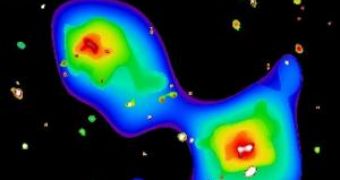Galaxy clusters are the biggest structures observed in the visible universe and while most of the times they are easy to spot and classify, apparently, some can evade detection by hiding behind other such huge clusters. This was the case of the galaxy cluster Abell 3128 that, when observed in the X-ray light spectrum, seemed to present two different images, both very close in brightness and size, which suggested two different chemical compositions of the same accumulation of matter.
However, we all know this is impossible, so astronomers decided to finally solve the mystery behind the elusive images. Observations provided by the XMM-Newton space telescope, revealed that Abell 3128 galaxy cluster presented two hot spots that are usually generated by large accumulations of hot gas glowing brightly in the X-ray domain; one that had a chemical composition rich in heavy elements, such as metals kicked out by powerful supernova explosions, and a second hot spot with lower metalicity content. However, the latter hot spot suggested that the image was not coming from the Abell 3128 galaxy cluster, but from another younger structure hidden from sight.
To get a better image of what the astronomers where seeing, they decided to make a survey of the area by using the Magellan Telescope in Chile, operating in the visible spectrum of light. Peaking through the center of the Abell 3128, and using the gravitational lensing phenomena produced by the powerful gravitational field of the galaxy cluster, astronomers where able to spot the image of a massive galaxy cluster situated farther behind the Abell 3128 galaxy cluster.
Preliminary calculations predict that it is situated at about 4.6 billion light years away, equivalent to more than six times the distance from Earth to the Abell 3128 cluster.
However, instead of celebrating the solving of the mystery of the X-ray images, and the discovery of another galaxy cluster, astronomers found themselves inside another puzzle, involving the question of how large could galaxy clusters and matter accumulations have been in the early stages of the universe. As the universe grows old, the inflation rate, or the speed at which it expands into space, increases exponentially, thus creating even larger voids or cavities between galaxies and galaxy clusters.
Nevertheless, from time to time gravitational pulls cause large amounts of mass to be drawn together, forming areas with high density of material as they collide and pass through each other. Due to the increased gravitational pull of the larger hot cloud of gas, most of the times these massive galaxy clusters have odd dynamics, which can only be studied by using X-ray space telescopes.
Launched from the French Guyana in 1999, the XMM-Newton X-ray space telescope operated by the European Space Agency and built by SRON, received recently a mission extension of another 5 years.

 14 DAY TRIAL //
14 DAY TRIAL //